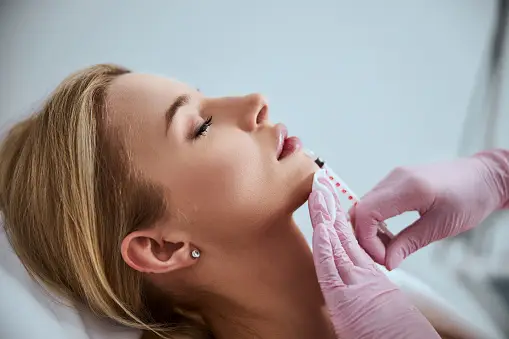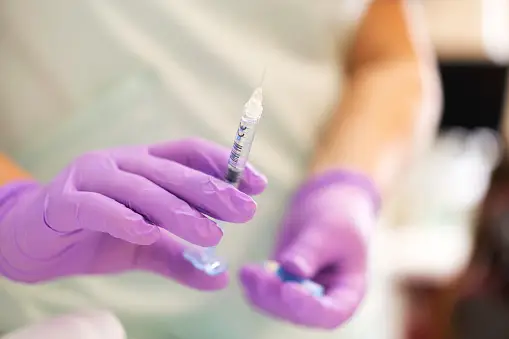Dermal fillers and injections are both cosmetic procedures that involve the use of injectable substances, but they serve different purposes and use different types of substances. Here’s a breakdown of the key differences between the two:
Purpose:
Dermal Fillers: Dermal fillers are primarily used to add volume and fullness to specific areas of the face, such as the lips, cheeks, and under-eye hollows. They can help smooth out wrinkles, fine lines, and creases, as well as enhance facial contours and restore lost volume.
Injections: “Injections” is a more general term that can refer to various types of injections, including but not limited to dermal fillers. Injections can also encompass procedures like Botox injections, which are used to temporarily relax facial muscles and reduce the appearance of dynamic wrinkles (wrinkles caused by muscle contractions).
Substances Used:
Dermal Fillers: Dermal fillers typically contain substances such as hyaluronic acid, calcium hydroxylapatite, poly-L-lactic acid, or polymethylmethacrylate (PMMA). These substances are designed to add volume and plump up the skin.
Injections: Injections can refer to a broader category of procedures that may involve various substances, including neuromodulators like Botox (which contain botulinum toxin) or other medications or treatments for various purposes beyond facial rejuvenation.
Mechanism of Action:
Dermal Fillers: Dermal fillers work by physically filling in and plumping up the targeted areas of the skin. They can add volume, smooth out wrinkles, and enhance facial features.
Injections (Botox, for example): Injections like Botox work by temporarily blocking nerve signals to specific facial muscles, which relaxes those muscles. This relaxation reduces muscle contractions, which, in turn, reduces the appearance of wrinkles caused by muscle movement.
Duration of Results:
Dermal Fillers: The duration of results with dermal fillers can vary depending on the type of filler used, the location of the injection, and individual factors. Typically, results last anywhere from several months to a year or more.
Injections (Botox): The effects of Botox injections are temporary and usually last for about three to six months. Maintenance treatments are typically required to sustain the results.
Common Uses:
Dermal Fillers: Common uses include lip augmentation, cheek enhancement, smoothing nasolabial folds and marionette lines, and filling in under-eye hollows.
Injections (Botox): Common uses include reducing the appearance of forehead lines, frown lines (between the eyebrows), and crow’s feet (lines around the eyes).
In summary, dermal fillers and injections serve different purposes in the field of cosmetic procedures. Dermal fillers are primarily used to add volume and enhance facial contours, while injections like Botox are used to temporarily relax muscles and reduce the appearance of wrinkles caused by muscle movements. The choice between the two depends on the specific cosmetic goals and concerns of the individual. It’s important to consult with a qualified medical professional to determine the most appropriate treatment for your needs.

What is the safest filler for face?
The safety of a dermal filler for the face depends on various factors, including the type of filler, the qualifications and experience of the healthcare provider administering the treatment, and the individual’s medical history and allergies. Overall, most dermal fillers approved by regulatory authorities like the U.S. Food and Drug Administration (FDA) and the European Medicines Agency (EMA) are considered safe when used by skilled and experienced practitioners. Here are some commonly used and FDA-approved dermal fillers for the face:
Hyaluronic Acid Fillers: Hyaluronic acid (HA) fillers are among the most popular and widely used dermal fillers. They are generally considered safe because HA is a naturally occurring substance in the body. Common HA fillers include brands like Juvederm, Restylane, and Belotero. HA fillers are reversible, as they can be dissolved with an enzyme called hyaluronidase in case of any issues.
Calcium Hydroxylapatite Fillers: Fillers containing calcium hydroxylapatite, such as Radiesse, are also FDA-approved for facial use. They provide longer-lasting results and stimulate collagen production. These fillers are generally considered safe when administered by experienced practitioners.
Poly-L-Lactic Acid Fillers: Poly-L-lactic acid (PLLA) fillers, like Sculptra, are used to stimulate collagen production and add volume to the face gradually. They are considered safe when administered properly.
Polymethylmethacrylate (PMMA) Fillers: PMMA fillers, such as Bellafill, are used for long-lasting results. They contain tiny microspheres that are not naturally absorbed by the body and provide a more permanent effect. These fillers are generally safe when used by experienced practitioners.
Autologous Fat Transfer: Fat transfer, also known as fat grafting, involves using the patient’s own fat harvested from one area of the body and injecting it into the face to add volume. Since it uses the patient’s tissue, there is no risk of allergic reactions. However, the success of the procedure can depend on various factors.
While these fillers are generally safe, it’s crucial to prioritize safety by:
Choosing a Qualified Provider: Ensure that you receive treatment from a board-certified dermatologist or plastic surgeon who has experience in administering dermal fillers.
Discussing Medical History: Be open and honest about your medical history, including any allergies or previous reactions to fillers, with your healthcare provider.
Following Aftercare Instructions: Follow post-treatment instructions provided by your healthcare provider to minimize the risk of complications.
Being Informed: Understand the potential risks and side effects associated with the specific filler you’re considering.
Considering Reversibility: If you have concerns about the permanence of a filler, discuss reversible options like HA fillers with your healthcare provider.
Ultimately, the choice of the safest filler for your face should be made in consultation with a qualified healthcare provider who can assess your individual needs and make recommendations based on your goals and medical history. Always prioritize safety and choose a reputable provider to minimize risks associated with facial fillers.
